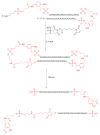Caged oligonucleotides for bidirectional photomodulation of let-7 miRNA in zebrafish embryos
- PMID: 23721917
- PMCID: PMC3789856
- DOI: 10.1016/j.bmc.2013.04.082
Caged oligonucleotides for bidirectional photomodulation of let-7 miRNA in zebrafish embryos
Abstract
Many biological functions of microRNA (miRNA) have been identified in the past decade. However, a single miRNA can regulate multiple gene targets, thus it has been a challenge to elucidate the specific functions of each miRNA in different locations and times. New chemical tools make it possible to modulate miRNA activity with higher spatiotemporal resolution. Here, we describe light-activated (caged) constructs for switching let-7 miRNA 'on' or 'off' with 365 nm light in developing zebrafish embryos.
Keywords: Antagomir; Let-7; MicroRNA (miRNA); Zebrafish.
Copyright © 2013 Elsevier Ltd. All rights reserved.
Figures







Similar articles
-
Antagonism of microRNA function in zebrafish embryos by using locked nucleic acid enzymes (LNAzymes).Chembiochem. 2012 Mar 5;13(4):584-9. doi: 10.1002/cbic.201100789. Epub 2012 Feb 7. Chembiochem. 2012. PMID: 22315191
-
Cocaine modulates the expression of opioid receptors and miR-let-7d in zebrafish embryos.PLoS One. 2012;7(11):e50885. doi: 10.1371/journal.pone.0050885. Epub 2012 Nov 30. PLoS One. 2012. PMID: 23226419 Free PMC article.
-
Spatiotemporal control of microRNA function using light-activated antagomirs.Mol Biosyst. 2012 Nov;8(11):2987-93. doi: 10.1039/c2mb25175b. Mol Biosyst. 2012. PMID: 22945263 Free PMC article.
-
Caged oligonucleotides for studying biological systems.J Inorg Biochem. 2015 Sep;150:182-8. doi: 10.1016/j.jinorgbio.2015.03.010. Epub 2015 Mar 28. J Inorg Biochem. 2015. PMID: 25865001 Free PMC article. Review.
-
Conditionally Activated ("Caged") Oligonucleotides.Molecules. 2021 Mar 9;26(5):1481. doi: 10.3390/molecules26051481. Molecules. 2021. PMID: 33803234 Free PMC article. Review.
Cited by
-
MicroRNA in teleost fish.Genome Biol Evol. 2014 Jul 22;6(8):1911-37. doi: 10.1093/gbe/evu151. Genome Biol Evol. 2014. PMID: 25053657 Free PMC article. Review.
-
Caged circular siRNAs for photomodulation of gene expression in cells and mice.Chem Sci. 2017 Oct 19;9(1):44-51. doi: 10.1039/c7sc03842a. eCollection 2018 Jan 7. Chem Sci. 2017. PMID: 29629072 Free PMC article.
-
Precision Control of Light-Responsive Nucleic Acids Modified with Photoremovable Protecting Groups for Functionalization.JACS Au. 2025 Jun 19;5(7):2953-2976. doi: 10.1021/jacsau.5c00524. eCollection 2025 Jul 28. JACS Au. 2025. PMID: 40747049 Free PMC article. Review.
-
Photoactivatable Circular Caged Oligonucleotides for Transcriptome In Vivo Analysis (TIVA).ChemPhotoChem. 2021 Oct;5(10):940-946. doi: 10.1002/cptc.202100098. Epub 2021 Jun 23. ChemPhotoChem. 2021. PMID: 35434268 Free PMC article.
-
Hydrogen peroxide-triggered gene silencing in mammalian cells through boronated antisense oligonucleotides.Chem Sci. 2017 Dec 6;9(5):1112-1118. doi: 10.1039/c7sc04318j. eCollection 2018 Feb 7. Chem Sci. 2017. PMID: 29629168 Free PMC article.
References
Publication types
MeSH terms
Substances
Grants and funding
LinkOut - more resources
Full Text Sources
Other Literature Sources
Molecular Biology Databases
Miscellaneous

